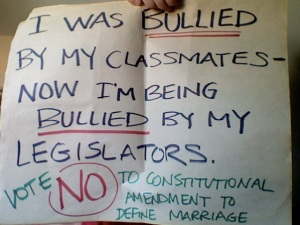I used to keep my opinions to myself, not make trouble. On May 21, 2011, a switch within me was flipped on and I am no longer the bystander I understood myself to be.
On that day, the Minnesota House of Representatives voted to send a ballot question to the people of the Land of Ten Thousand Lakes, giving Minnesota the unfortunate opportunity to vote on the rights of a minority group–whether or not marriage should be defined [restricted] as a union only between a man and a woman, thereby creating one group that can marry and another group that can’t, should the proposed amendment pass.
Prior to May 21, 2011, even in my bystander status, I had been generally aware of the dynamics of oppression and had been learning about systemic and structural “-isms” in recent years: racism, classism, sexism. And heterosexism.
More recently, I’ve been focusing on four specific dynamics of society that seem to feed off of each other, reinforce each other, and perpetuate all forms of oppression.
Furthermore, since May 21, I clearly see and am witness to how the interpersonal oppression* experienced these days by the GLBTQ community feeds off of those same four dynamics:
- Shame;
- Silence;
- Stigma; and
- the Socialization of the above three as “norms.”
It’s not all bad news and a downward spiral, though. From where I sit, and from other experiences I’ve had with overcoming oppression, there are antidotes and ways to transcend these four harmful dynamics.
- Connection transcends shame;
- Speaking out transcends silence;
- Unconditional acceptance transcends stigma; and
- Reclaiming our true, essential nature transcends the false norms we internalize through the socialization process.
When we begin to identify examples of when and how the media, politicians, schools, policy, religion, law enforcement, the legal system, and other structures of society reinforce stigma, point fingers, and assign blame to the minority group that has been historically oppressed, we can then “pull back the curtain” that has covered our eyes all these years.
The curtain falls away and we see the socialization process at work. For the lucky ones who look like, pray like, have money like, or love like those who make decisions and are in positions of power, that socialization bestows privileges, access, and rewards, further helping those with privilege to garner more privilege.
For the unlucky ones who look different, pray different, don’t have a lot of money, or love different, the socialization process and those who reinforce it either shame us, silence us, or stigmatize us.
And when we finally see how that socialization process happens, we can never become blind to it again. In fact, we help others see it happen, too. When we help enough people see and understand the socialization process, we can work together to name it openly and find the historic trajectory of how we’ve been socialized to accept or reject certain behaviors, thoughts, and attitudes.
The more we challenge, examine, and illuminate the unbridled socialization process that has led to giving privileges to some while erecting barriers and for others, the more we aid in the development of a new pattern, a new trajectory–often equal but opposite from the oppressive one–that affirms equality, justice, and fairness for all of us.
———————–
*Interpersonal oppression is one stepping stone that leads to the larger, more insidious, ominpresent, and intractable structural oppression, in which systems of society are bound together by the cords of oppression. Such systems include but are not limited to education, public policy, the media, the legal system, economics, religion, politics, law enforcement, etc. Here’s an overview of terms and dynamics related to oppression.


Written by Two Cranes
Comments Off on The socialization process of oppression and how to heal from it